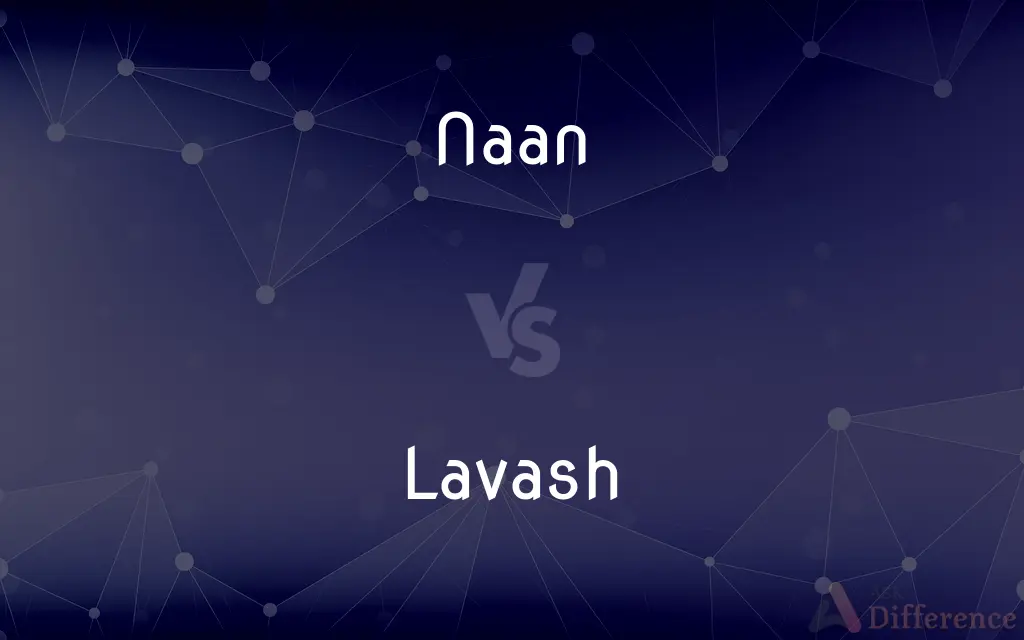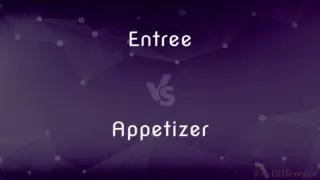Naan vs. Lavash — What's the Difference?
By Maham Liaqat & Urooj Arif — Updated on March 10, 2024
Naan is a leavened, oven-baked flatbread found in Indian cuisine, while lavash is an unleavened flatbread common in Armenian and Middle Eastern cuisines.

Difference Between Naan and Lavash
Table of Contents
ADVERTISEMENT
Key Differences
Naan and lavash are both types of flatbread, integral to their respective culinary traditions, but they differ fundamentally in ingredients and preparation methods. On the other hand, lavash is an unleavened flatbread made primarily from wheat flour and water. The lack of leavening agents results in a thinner, more flexible bread.
Naan is traditionally made with wheat flour and is leavened with yeast or baking powder, which gives it a soft and fluffy texture. It is typically baked in a tandoor, a cylindrical clay oven, which imparts a distinct smoky flavor. Lavash is traditionally cooked on the walls of a tandoor or on a flat griddle, leading to a slightly crispy texture when fresh that becomes softer and more pliable as it cools.
The geographical origins and cultural significance of naan and lavash also highlight their distinctions. Naan is deeply rooted in Indian and Central Asian cuisines, often served with curry or kebabs, reflecting its importance in communal and familial settings. Lavash, meanwhile, is a staple in Armenian, Turkish, and Iranian cuisines, symbolizing prosperity and used in various ceremonies.
More variations in seasoning and flavoring distinguish naan and lavash. Naan often includes dairy products like yogurt or milk in its dough, contributing to its richness and tender crumb. It can also be flavored with garlic, herbs, or nigella seeds. Lavash, being simpler in its traditional form, is usually not seasoned, though modern variations may include sesame or poppy seeds.
The cooking method not only affects the bread's texture but also its appearance and usage. Naan's fluffy, tearable texture makes it an ideal accompaniment for scooping up sauces and gravies. Lavash, with its flexibility, is often used as a wrap for kebabs and other fillings or torn into pieces for dipping in hummus or baba ganoush.
ADVERTISEMENT
Comparison Chart
Leavening
Leavened (yeast or baking powder)
Unleavened
Origin
Indian and Central Asian
Armenian, Turkish, Iranian
Texture
Soft and fluffy
Thin and flexible
Common Ingredients
Wheat flour, water, yeast/baking powder, dairy (optional)
Wheat flour, water
Cooking Method
Baked in a tandoor oven
Baked on a tandoor wall or flat griddle
Compare with Definitions
Naan
Bread that has been made light and porous by the action of yeast or other leavening agents.
We opted for naan, a type of leavened bread, to go with our meal.
Lavash
A traditional unleavened flatbread common in Armenian and Middle Eastern cuisines, known for its flexibility.
We wrapped the grilled meats and vegetables in lavash for a delicious meal.
Naan
A soft, leavened flatbread baked in a tandoor, originating from Indian cuisine.
The butter naan was the perfect accompaniment to the rich chicken curry.
Lavash
Bread that is rolled out thinly before cooking, resulting in a lighter, crisper texture.
The thin bread, lavash, crisped up nicely when toasted, making it a great snack.
Naan
A category of bread that includes naan, recognized for its soft texture and versatility in meals.
For an authentic Indian meal, try the garlic naan, a flavorful variety of Indian flatbread.
Lavash
Bread made without any leavening agents, resulting in a thinner, denser product.
Lavash, being an unleavened bread, is perfect for making wraps and rolls.
Naan
Cooked in a cylindrical clay oven that provides a unique charred flavor.
The naan, tandoor-baked to perfection, had a deliciously smoky aroma.
Lavash
Bread that can be easily bent or wrapped without breaking.
Lavash's flexibility makes it ideal for both wraps and as a base for pizzas.
Naan
Bread that rises due to the fermentation action of yeast.
The yeast-leavened naan puffed up beautifully in the heat of the tandoor.
Lavash
A category of bread that includes lavash, valued for its versatility in regional dishes.
The hummus was served with pieces of lavash, a popular Middle Eastern flatbread.
Naan
Naan (Persian: نان, romanized: nān, Pashto : نان Dari: نان, Punjabi: ਨਾਨ, Hindi: नान, Bengali: নান) is a leavened, oven-baked flatbread found in the cuisines mainly of Western Asia, Indian subcontinent, Indonesia, Myanmar and the Caribbean.
Lavash
Lavash is a thin flatbread usually leavened, traditionally baked in a tandoor (tonir) or on a sajj, and common to the cuisines of South Caucasus, Western Asia, and the areas surrounding the Caspian Sea. Lavash is one of the most widespread types of bread in Armenia, Azerbaijan, Iran and Turkey.
Naan
A flat, leavened bread of northwest India, made of wheat flour and baked in a tandoor.
Lavash
A thin unleavened flatbread of Armenian origin.
Naan
A type of round, flat bread baked in a tandoor popular in South and Central Asian cuisine.
Lavash
A soft, thin flatbread made with flour, water, yeast, and salt, baked in a tandoor. Toasted sesame seeds and/or poppy seeds are sometimes sprinkled on it before baking. Traditionally made in Armenia and other countries of the Caucasus and the Middle East.
Common Curiosities
Are there gluten-free versions of naan and lavash?
Yes, gluten-free versions can be made using alternative flours, such as rice flour or almond flour.
Can naan be made without a tandoor?
Yes, naan can be baked in a conventional oven or cooked on a skillet, though the flavor will be slightly different.
What dishes are naan and lavash typically served with?
Naan is often served with curries and kebabs, while lavash is used for wraps and served with dips.
How do cultural traditions influence the serving of naan and lavash?
Cultural traditions shape how these breads are served, with naan often playing a central role in Indian dining and lavash in Middle Eastern ceremonies.
What is the shelf life of naan and lavash?
Both should be consumed fresh but can last a few days if stored properly; lavash can also be dried for longer storage.
Can I use naan as a wrap like lavash?
While naan is softer and thicker, it can still be used as a wrap, though it may not be as flexible as lavash.
Is naan or lavash better for scooping up sauces?
Naan's fluffy texture makes it ideal for scooping up sauces and gravies.
Do naan and lavash have the same ingredients?
Both use wheat flour and water, but naan often includes yeast or baking powder and sometimes dairy.
Which is healthier, naan or lavash?
Lavash is generally lower in calories and fat due to the absence of dairy and leavening agents.
How are naan and lavash traditionally cooked?
Naan is baked in a tandoor, while lavash is cooked on the walls of a tandoor or on a flat griddle.
Can I add toppings to naan and lavash?
Yes, both can be topped or filled with various ingredients, though naan is more commonly seasoned or stuffed.
Are naan and lavash suitable for vegetarians?
Yes, both are generally suitable for vegetarians, though it's important to check for dairy in naan if vegan.
What is the main difference between naan and lavash?
Naan is a leavened, soft flatbread baked in a tandoor, while lavash is an unleavened, thin bread.
Is lavash always served cold?
No, lavash can be served fresh and warm but becomes softer and more pliable as it cools.
Can naan and lavash be frozen?
Yes, both can be frozen and reheated, though their textures may slightly change.
Share Your Discovery

Previous Comparison
Entree vs. Appetizer
Next Comparison
Cute vs. AdorableAuthor Spotlight
Written by
Maham LiaqatCo-written by
Urooj ArifUrooj is a skilled content writer at Ask Difference, known for her exceptional ability to simplify complex topics into engaging and informative content. With a passion for research and a flair for clear, concise writing, she consistently delivers articles that resonate with our diverse audience.















































